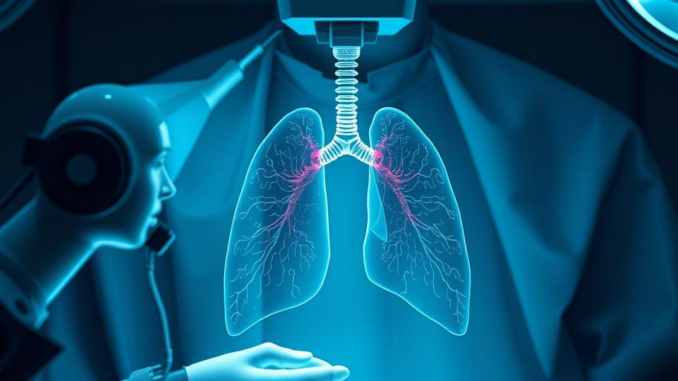
Summary
Johnson & Johnson MedTech receives FDA clearance for MONARCH QUEST, a groundbreaking advancement in robotic-assisted bronchoscopy. This AI-powered technology enhances accuracy and speed in lung cancer diagnosis, potentially revolutionizing treatment. This innovation offers minimally invasive access to peripheral lung nodules, previously difficult to reach with traditional methods.
** Main Story**
Okay, so I was reading about this new tech from Johnson & Johnson MedTech, MONARCH QUEST. You heard about it? The FDA just gave it the green light. It’s basically a souped-up version of their robotic-assisted bronchoscopy system, aimed at tackling lung cancer diagnosis. And honestly, it sounds pretty impressive.
MONARCH QUEST: A New Era in Lung Cancer Diagnosis
Lung cancer’s a killer, right? We all know someone, or know someone, who’s been affected. The problem is, so often it’s caught way too late. That’s why early detection is such a big deal, and why I think this MONARCH QUEST thing could be a real game changer. It builds on their existing MONARCH Platform, which, by the way, was already the first robotically assisted bronchoscopy system out there. The key thing, I think, is how they’ve designed the scope. It’s got this scope-in-sheath thing going on that gives you a really stable view, which is crucial when you’re trying to navigate through all those tiny airways.
But here’s where it gets really interesting. MONARCH QUEST takes things to the next level by adding AI and linking up with GE HealthCare’s OEC 3D mobile CBCT Imaging System. Think about it, combining really advanced imaging with AI-powered navigation. The result? Way better accuracy when you’re trying to pinpoint those suspicious nodules. Plus, it uses NVIDIA’s accelerated computing platform, based on NVIDIA RTX, and that’s no joke. It cranks up the real-time computational power by a whopping 260%. I mean, come on, that’s crazy. This jump in computing power lets them use algorithms that boost confidence and precision. And that means getting to those hard-to-reach spots in the lungs, where almost half of the early-stage lesions are hiding. You can’t get to them? You can’t diagnose the problem. End of discussion.
AI-Powered Precision and Faster Diagnosis
The AI, I’m telling you, is the real secret sauce here. It helps doctors navigate all the twists and turns in the lungs, making it more likely they’ll actually find and biopsy those suspicious spots. You know, even the ones tucked away in the periphery, and let’s face it, the early you diagnose lung cancer, the better the odds are.
I remember reading about this study on the original MONARCH Platform, where they showed it could speed up the diagnostic process by, like, three weeks on average. Getting patients into treatment faster really does make a difference. And if MONARCH QUEST is even better, which it seems like it is, we could be looking at even faster interventions and better outcomes. What’s not to like?
The Future of Lung Cancer Care
This MONARCH QUEST thing feels like a turning point. The better navigation, the AI smarts, and linking it all up with advanced imaging, it’s all aimed at changing how we deal with this killer disease. The digital ecosystem aspect of the MONARCH Platform connects data across the board, leveraging the massive reach of Johnson & Johnson. I guess it’s a holistic approach to improving lung cancer care. You know, from planning the surgery to actually doing it to figuring out what happened afterwards.
Who knows what the future holds? But with robotic-assisted bronchoscopy getting more and more popular, and with innovations like this MONARCH QUEST leading the way, I’m actually feeling a bit optimistic. I mean, imagine a world where early diagnosis is just the norm. It would be nice wouldn’t it? It gives you hope.


Given the reliance on NVIDIA’s RTX platform for computational power, how adaptable is MONARCH QUEST to facilities with varying levels of existing infrastructure and resources for AI implementation?
That’s a great question! While MONARCH QUEST benefits significantly from NVIDIA’s RTX, the system is designed with modularity in mind. This allows for a tiered implementation approach, ensuring facilities can leverage the core benefits while gradually upgrading their infrastructure. The integrated AI also assists, reducing the immediate burden on local computational resources. #LungCancerDiagnosis #MedTechInnovation
Editor: MedTechNews.Uk
Thank you to our Sponsor Esdebe
So, are we going to see robot bronchoscopies battling it out in the OR? Jokes aside, the AI-powered precision sounds like a major leap. How long until it can make a decent cup of coffee too?
That’s a fun thought! While robotic bronchoscopies battling it out might be a bit further down the line, the precision gains from AI are definitely here. The coffee-making capabilities are an interesting challenge though. Perhaps with enough data, it could learn the perfect brew! What other tasks could we give it?
Editor: MedTechNews.Uk
Thank you to our Sponsor Esdebe
AI’s finding the nodules, but who’s finding the time to train the AI? Does this mean doctors get to trade textbooks for NVIDIA manuals now?